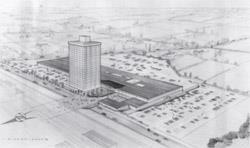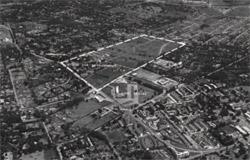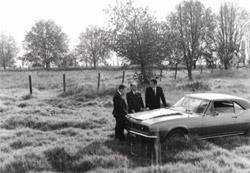The iconic Sandton City Shopping Centre located in the financial district of Sandton in Johannesburg first opened its doors on 12 September 1973.

The Star, November 1969: “A massive new ‘city’ will be built in Sandton during the next few years. The complex will be larger than Johannesburg’s business centre. The numerous developments will cost twice as much as the original Carlton Centre estimates and will be a city in itself.”
Some 50 years ago, the land where the towering super regional shopping centre is located was snaked by sandy horse trails and a farming community.
The creation of the Sandton City Shopping Centre helped to transform Sandton from a farming community into a bustling business district, says Mel Urdang, director of retail at Liberty Properties.
He says when walking along the streets of Africa’s richest square mile surrounded by Manhattan-style skyscrapers, opulent houses, office towers, international and locally renowned brands and exotic cars, it is hard to believe that Sandton was merely sandy horse trails and grassy estates just 50 years ago.
The centre is owned by the Johannesburg Stock Exchange (JSE) listed company, Liberty Holdings of which Liberty Properties is a division. Liberty owns a 75 percent stake and Pareto Limited holds a 25 percent stake in the Sandton City Shopping Centre.
The shopping centre is located on 5thStreet and Rivonia Road in Sandown, Sandton Central and is managed by Liberty Properties.
“The Sandton area now represents the second largest office node in South Africa, following behind the Johannesburg CBD.”
Sandton has become home to major financial, consulting and banking firms in South Africa, with a substantial 7 to 10 percent of South African JSE listed companies having postal addresses in Sandton, he says.
From rural beginnings
Urdang explains that Sandton City was constructed by Rapp and Maister in the early 1970s.
It was nearly called Knoppieslaagte City Shopping Centre but the developers then decided that the name Sandton City was more suitable.
In 1969, the Johannesburg Town Council proclaimed a new municipality.
Its name, Sandton, was taken from the names of the two suburbs of Sandhurst and Bryanston which it incorporated.

Developers Michael Rapp and brothers Hilliard and Eli Liebowitz acquired 32 hectares of land in Sandhurst intending to build private homes, flats and a small shopping centre, but plans were later changed to fit in with the proposed Sandton Central Business District. A number of houses including 12 new luxury homes were demolished to make way for the complex that promised to transform Sandton into a high-rise city with offices and buildings of up to 20 storeys.
The municipality’s decision to rezone the area was based on the need for another focal point or town centre point, in Johannesburg.
He says this was mainly because there was a growing unhappiness with the Johannesburg CBD in terms of parking, which was becoming increasingly scarce and also restrictive thanks to the parking meter system.
“It was Michael Rapp of Rapp & Maister, which was later incorporated into Liberty Properties who pioneered the development of the mall and tower that would one day become the heart of a new and vibrant city.”
At the time when Sandton was proclaimed, Rapp & Maister had already purchased the site which was originally intended to become an upmarket residential development of just 12 houses, with additional rights granted for a high-rise residential apartment block and a small commercial section.
In fact, the housing development had progressed so far that four of these houses were already at roof level.
Urdang says what happened next is vividly described by author Ken Romain in his book Larger than Life: Donald Gordon and the Liberty Life Story (Jonathan Ball, 1989).
“…the plans were changed dramatically as Michael Rapp rapidly grasped the importance of the site he had assembled on land adjoining the new town’s city centre.
Despite objections, noisy public hearings and all possible obstruction by the – mostly rich and influential – residents of the area (one of whom, the late Ian MacPherson, was a director of Liberty Life) consents for the office and shop development, as opposed to the original residential-only zoning, were granted in 1973.”
Gavin Main, then director of Rapp and Maister Real Estate, explains that the vehemence of the objections was mainly due to the fact that the locals were outraged to discover that the additional rights which Rapp had applied for after Sandton were proclaimed included the building of a 20-storey office tower in the midst of their suburban paradise.
“All hell broke loose, but nothing could be done to stop it as all legal processes had been correctly followed by Rapp and Maister, it was a fait accompli,” Main recalls.
He says the process was not all smooth sailing.
In order for permissions to be obtained, Rapp had to elicit the support of the new Sandton Town Council whose opinions on the matter were divided.
One of the biggest stumbling blocks was the potential traffic problem that the new centre would create.
“In order for the plans to be approved, we had to pay a substantial development contribution which was primarily used to widen Sandton Drive and create a road through to Katherine Street to optimise the traffic flow.”
During that time, Rapp and Maister did not own the entire area on which Sandton City stands.

Developers Natie Maister and David Rapp from Rapp & Maister study the building plans on the boot of a car at the Sandton City construction site. The land was bought for R4 million over a period of two years from June 1967 to April 1969, at an average of R40 000 per acre.
Two properties on the south-east corner were privately owned and these had to be acquired by the developers in order for the project to go ahead.
Main explains that the company briefed estate agents to approach the property owners discreetly and submit offers to purchase.
One property owner agreed immediately and sold his stand for the going rate of R40 000 at the time and the other owner quickly cottoned on to the strategic importance of his land.
Main says the owner refused to sell until eventually with time running out for Rapp and Maister, he was made a “Godfather offer” of R100 000, two and a half times the market value of the property, which the owner accepted and construction of Sandton City began.
Main remembers that the development of the land required massive financing and Michael Rapp’s father David, the founder of Rapp and Maister, nearly had an apoplectic fit over the R20 million debenture which would be required.
“This was one of the biggest ever contemplated in South African history for such an endeavour.”
Main explains that David told his son that he was nuts and would destroy the company with such borrowings.
You see, David was a conservative man who had always approached development in a different way having started Rapp and Maister from humble beginnings.
“It was originally a bakery before he began his first building project in Yeoville and the Sandton development was speculative.”
“David did not think it would be let or that rentals were reasonable. Michael Rapp had the foresight very few others possessed and to this day I am full of admiration for him,” points out Main.
He notes that in the early 1970s, the Johannesburg CBD was a thriving metropolis and the destination of choice for shoppers.
Hyde Park Centre existed but was far smaller than it is today and the Rosebank Mall provided a good mix of shops and restaurants, but, like the CBD, had a major parking problem.
Through Michael’s international travels and exposure to a new concept which at that time was entirely unfamiliar to South Africans, a covered and enclosed mall that was a one-stop destination for shoppers was developed.
The Sandton development was mainly inspired by two leading international malls, the Centre Commercial Parly 2 in Versailles in France and the Yorkdale Shopping Centre in Toronto, Canada.
This opened in 1964 and at the time was the largest shopping centre in the world.
It also had a new and novel system for its deliveries. While many shopping malls had receiving doors at the back of the centre, Yorkdale had a two-lane road for trucks that ran under the centre and led directly to the retailers’ basement storage areas.
This was no doubt what inspired the state-of-the-art truck tunnel that today still facilitates Sandton City’s deliveries, he says.
At 30 000 square metres of mall space plus an office tower, the first stage of the Sandton City development was far smaller than these two international giants and was a simple rectangular design.
The L-shape was only created in the next phase of expansion because, initially, business rights were granted over a relatively small portion of the site.
Rapp then strategically utilised the remainder for parking and pending rezoning.
Although many people have marvelled at the strategic planning which saw Sandton City located on the highest piece of land in the area, allowing the tower to be visible from almost any point in Johannesburg, Rapp explains: “It was the access from the newly built freeway between Johannesburg and Pretoria which dictated the exact location of the mall and office tower.”

The catalyst for Sandton’s dramatic growth was Sandton City, started in 1970 and opened in 1973. Many considered the new development a white elephant, doomed to fail. Silencing its critics, the office tower was fully let almost from day one and the shopping centre was an unprecedented success. Built to service not only the region but its immediate community, Sandton City had places to tether horses and a laundromat where locals who did not own washing machines could get their whites washed whiter.
Rapp was a true entrepreneur and a larger-than-life figure. Urdang says he believes that if anyone was to have pulled off the unlikely scenario of a successful shopping mall in a semi-rural area which was at the time outside the city boundaries, it had to have been individuals of the stature and connectivity of Michael Rapp and Donald Gordon.
“They managed to forge the relationships that ensured the leading retailers would lease space in Sandton City.”
Urdang puts it this way: That is not something just any developer could have done, but because these men were heading the organisations they did; were the people they were and mixed in the circles they did, they prevailed.
Rapp and Gordon approached the best of the best to set up shop in Sandton City, people who like themselves were entrepreneurs.
Rapp also explains that from the beginning, the tenant mix in Sandton City is what sets it apart and this was very carefully planned and thought out.
“The strategy was to ensure that we always represented every retailer, large and small, giving the shopper wide choices and price comparisons,” he says.
Read our next article when Sandton City first opened its doors for trading on 12 September 1973.
Credits: Special thanks to Mel Urdang, Liberty Properties retail director and his team as well as the Sandton Central Management District (SCMD) for providing the historic pictures and captions of Sandton City and Marie Human who was the curator of the SCMD Heritage Project.
Do you remember Sandton as a farming area and horse trail land? Share your views and thoughts about the history of Sandton below.









